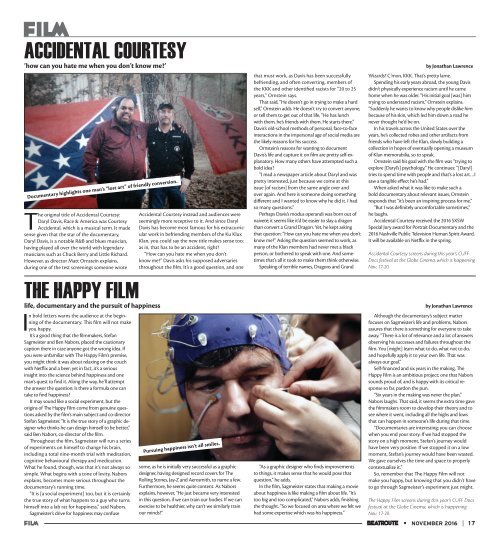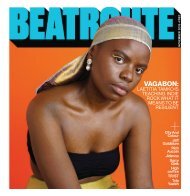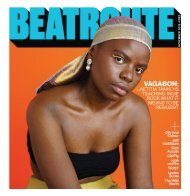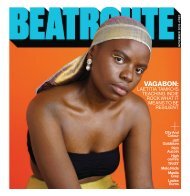BeatRoute Magazine Alberta print e-edition - November 2016
BeatRoute Magazine is a monthly arts and entertainment paper with a predominant focus on music – local, independent or otherwise. The paper started in June 2004 and continues to provide a healthy dose of perversity while exercising rock ‘n’ roll ethics.
BeatRoute Magazine is a monthly arts and entertainment paper with a predominant focus on music – local, independent or otherwise. The paper started in June 2004 and continues to provide a healthy dose of perversity while exercising rock ‘n’ roll ethics.
You also want an ePaper? Increase the reach of your titles
YUMPU automatically turns print PDFs into web optimized ePapers that Google loves.
FILM<br />
ACCIDENTAL COURTESY<br />
‘how can you hate me when you don’t know me?’<br />
Documentary highlights one man’s “lost art” of friendly conversion.<br />
The original title of Accidental Courtesy:<br />
Daryl Davis, Race & America was Courtesy<br />
Accidental, which is a musical term. It made<br />
sense given that the star of the documentary,<br />
Daryl Davis, is a notable R&B and blues musician,<br />
having played all over the world with legendary<br />
musicians such as Chuck Berry and Little Richard.<br />
However, as director Matt Ornstein explains,<br />
during one of the test screenings someone wrote<br />
THE HAPPY FILM<br />
life, documentary and the pursuit of happiness<br />
In bold letters warns the audience at the beginning<br />
of the documentary: This film will not make<br />
you happy.<br />
It’s a good thing that the filmmakers, Stefan<br />
Sagmeister and Ben Nabors, placed the cautionary<br />
caption there in case anyone got the wrong idea. If<br />
you were unfamiliar with The Happy Film’s premise,<br />
you might think it was about relaxing on the couch<br />
with Netflix and a beer; yet in fact, it’s a serious<br />
insight into the science behind happiness and one<br />
man’s quest to find it. Along the way, he’ll attempt<br />
the answer the question: Is there a formula one can<br />
take to find happiness?<br />
It may sound like a social experiment, but the<br />
origins of The Happy Film come from genuine questions<br />
asked by the film’s main subject and co-director<br />
Stefan Sagmeister. “It is the true story of a graphic designer<br />
who thinks he can design himself to be better,”<br />
said Ben Nabors, co-director of the film.<br />
Throughout the film, Sagmeister will run a series<br />
of experiments on himself to change his brain,<br />
including a total nine-month trial with meditation,<br />
cognitive behavioural therapy and medication.<br />
What he found, though, was that it’s not always so<br />
simple. What begins with a tone of levity, Nabors<br />
explains, becomes more serious throughout the<br />
documentary’s running time.<br />
“It is [a social experiment] too, but it is certainly<br />
the true story of what happens to a guy who turns<br />
himself into a lab rat for happiness,” said Nabors.<br />
Sagmeister’s drive for happiness may confuse<br />
FILM<br />
Accidental Courtesy instead and audiences were<br />
seemingly more receptive to it. And since Daryl<br />
Davis has become most famous for his extracurricular<br />
work in befriending members of the Ku Klux<br />
Klan, you could say the new title makes sense too;<br />
as in, that has to be an accident, right?<br />
“How can you hate me when you don’t<br />
know me?” Davis asks his supposed adversaries<br />
throughout the film. It’s a good question, and one<br />
Pursuing happiness isn’t all smiles.<br />
some, as he is initially very successful as a graphic<br />
designer, having designed record covers for The<br />
Rolling Stones, Jay-Z and Aerosmith, to name a few.<br />
Furthermore, he seems quite content. As Nabors<br />
explains, however, “He just became very interested<br />
in this question, if we can train our bodies. If we can<br />
exercise to be healthier, why can’t we similarly train<br />
our minds?”<br />
that must work, as Davis has been successfully<br />
befriending, and often converting, members of<br />
the KKK and other identified racists for “20 to 25<br />
years,” Ornstein says.<br />
That said, “He doesn’t go in trying to make a hard<br />
sell,” Ornstein adds. He doesn’t try to convert anyone,<br />
or tell them to get out of that life. “He has lunch<br />
with them, he’s friends with them. He starts there.”<br />
Davis’s old-school methods of personal, face-to-face<br />
interactions in the impersonal age of social media are<br />
the likely reasons for his success.<br />
Ornstein’s reasons for wanting to document<br />
Davis’s life and capture it on film are pretty self-explanatory.<br />
How many others have attempted such a<br />
bold idea?<br />
“I read a newspaper article about Daryl and was<br />
pretty interested, just because we come at this<br />
issue [of racism] from the same angle over and<br />
over again. And here is someone doing something<br />
different and I wanted to know why he did it. I had<br />
so many questions.”<br />
Perhaps Davis’s modus operandi was born out of<br />
naiveté; it seems like it’d be easier to slay a dragon<br />
than convert a Grand Dragon. Yet, he kept asking<br />
that question: “How can you hate me when you don’t<br />
know me?” Asking the question seemed to work, as<br />
many of the Klan members had never met a black<br />
person, or bothered to speak with one. And sometimes<br />
that’s all it took to make them think otherwise.<br />
Speaking of terrible names, Dragons and Grand<br />
“As a graphic designer who finds improvements<br />
to things, it makes sense that he would pose that<br />
question,” he adds.<br />
In the film, Sagmeister states that making a movie<br />
about happiness is like making a film about life. “It’s<br />
too big and too complicated,” Nabors adds, finishing<br />
the thought. “So we focused on area where we felt we<br />
had some expertise which was his happiness.”<br />
by Jonathan Lawrence<br />
Wizards? C’mon, KKK. That’s pretty lame.<br />
Spending his early years abroad, the young Davis<br />
didn’t physically experience racism until he came<br />
home when he was older. “His initial goal [was] him<br />
trying to understand racism,” Ornstein explains.<br />
“Suddenly he wants to know why people dislike him<br />
because of his skin, which led him down a road he<br />
never thought he’d be on.<br />
In his travels across the United States over the<br />
years, he’s collected robes and other artifacts from<br />
friends who have left the Klan, slowly building a<br />
collection in hopes of eventually opening a museum<br />
of Klan memorabilia, so to speak.<br />
Ornstein said his goal with the film was “trying to<br />
explore [Daryl’s] psychology.” He continues: “[Daryl]<br />
tries to spend time with people and that’s a lost art…I<br />
saw a tangible effect he’s had.”<br />
When asked what it was like to make such a<br />
bold documentary about relevant issues, Ornstein<br />
responds that “it’s been an inspiring process for me.”<br />
“But I was definitely uncomfortable sometimes,”<br />
he laughs.<br />
Accidental Courtesy received the <strong>2016</strong> SXSW<br />
Special Jury award for Portrait Documentary and the<br />
<strong>2016</strong> Nashville Public Television Human Spirit Award.<br />
It will be available on Netflix in the spring.<br />
Accidental Courtesy screens during this year’s CUFF<br />
Docs festival at the Globe Cinema, which is happening<br />
Nov. 17-20.<br />
by Jonathan Lawrence<br />
Although the documentary’s subject matter<br />
focuses on Sagmeister’s life and problems, Nabors<br />
assures that there is something for everyone to take<br />
away. “There is a lot of relevance and a lot of answers<br />
observing his successes and failures throughout the<br />
film. You [might] learn what to do, what not to do,<br />
and hopefully apply it to your own life. That was<br />
always our goal.”<br />
Self-financed and six years in the making, The<br />
Happy Film is an ambitious project; one that Nabors<br />
sounds proud of, and is happy with its critical response<br />
so far, pardon the pun.<br />
“Six years in the making was never the plan,”<br />
Nabors laughs. That said, it seems the extra time gave<br />
the filmmakers room to develop their theory and to<br />
see where it went, including all the highs and lows<br />
that can happen in someone’s life during that time.<br />
“Documentaries are interesting; you can choose<br />
when you end your story. If we had stopped the<br />
story on a high moment, Stefan’s journey would<br />
have been very positive. If we stopped it on a low<br />
moment, Stefan’s journey would have been wasted.<br />
We gave ourselves the time and space to properly<br />
contextualize it.”<br />
So, remember that The Happy Film will not<br />
make you happy, but knowing that you didn’t have<br />
to go through Sagmeister’s experiment just might.<br />
The Happy Film screens during this year’s CUFF Docs<br />
festival at the Globe Cinema, which is happening<br />
Nov. 17-20.<br />
BEATROUTE • NOVEMBER <strong>2016</strong> | 17


















